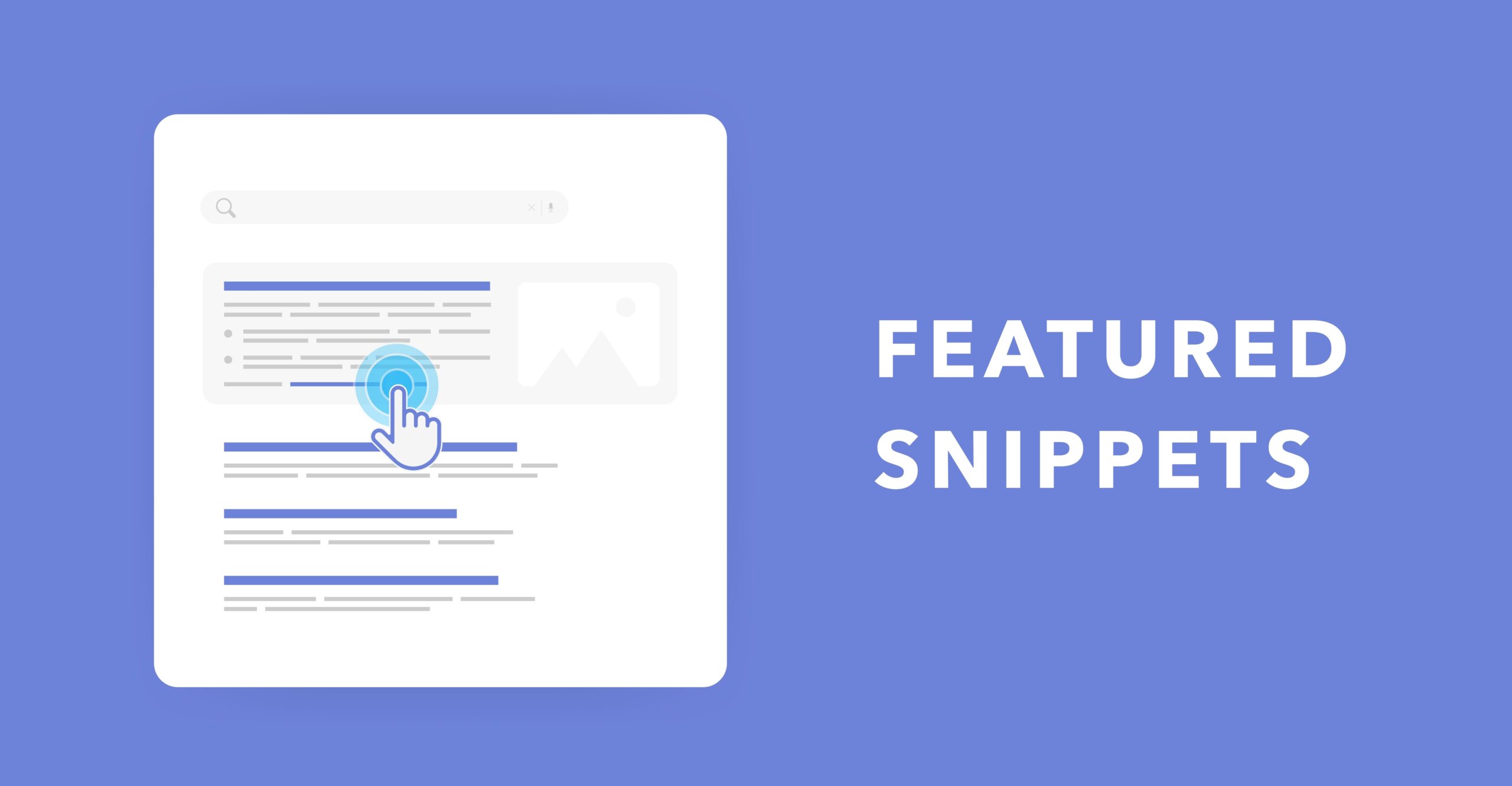Have you ever noticed that not all search results pages in Google look the same?
That’s because Google displays results differently depending on the data it can extract from each web page.
Website owners use different SEO techniques like structured data to try and manipulate their Google rankings and search result displays in their favour.
One example of a Google Search result display type is a featured snippet, which ranks highly.
A featured snippet is a snapshot of a post, which provides users with the top level information they need to answer their query, without clicking through to a link.
It’s basically Google’s way of displaying the answer to a question, without you having to click through to another website.
If you’re confused about snippets and structured data, read through our useful guide to understand the basics.
By the end you’ll know:
- What featured snippets are
- What structured data is
- Why you should care about them
- How to use them to your advantage
What are featured snippets?
Sometimes when you do a Google search, a large box appears as the top result.
This is the featured snippet that Google chooses to display for that search.
Google takes the snippet of information from a web page which answers the query within its content.
Featured snippets are commonly known as “answer boxes” because they provide the best response, or information that’s most likely to answer the search query.
They also display the page title and link so people can click through to the page on the original website.
Instant answers, rich results, and knowledge graphs are not featured snippets.
Featured snippets appear below the paid ads and above the organic search results, which is referred to as “rank zero”.
There’s only one featured snippet per search query, so there’s lots of competition for that top spot.
Unfortunately, you can’t create a featured snippet yourself.
Google selects featured snippets themselves based on structured data (see below) and meta tags.
But, you can structure the content on your website to increase the chances of appearing as the featured snippet in the search results.
What types of featured snippets are there?
A featured snippet doesn’t just appear as a box of text. There are several kinds of featured snippets that Google extracts from websites.
Paragraphs
Paragraph snippets appear as a small blurb of text. They’re the most common snippet type and tend to answer “who/how/what/why” queries. They sometimes include a thumbnail image.
Lists
List snippets provide answers by presenting the text in a step-by-step list. This can be a numbered list or bullet points. It’s the second most common snippet type and answers process-driven queries with “how to” guides.
Tables
Table snippets present information structured in an easy-to-read table, usually pulled from the original page. They tend to answer data-based questions such as prices or ratings.
Videos
Video snippets are videos embedded on the page that contain answers to queries in visual/audio format. Google pulls these snippets from places like YouTube based on the video description and title. Sometimes Google features the whole video, sometimes only a clip by highlighting a timestamp.
Accordions
A snippet with an accordion is expandable to reveal additional information that could answer the searcher’s questions in further detail.
Tools or calculators
If you provide an interactive tool on your website, Google might present this as a featured snippet if its output can answer a search query. The tool could be for things like converting measurements, completing a calculation, or figuring out time zones or weather information.
Carousel snippets
You might see a carousel of little bubbles at the top or bottom of the featured snippet space containing related keywords. Click on any of these and it’ll take you to a different featured snippet.
Double-featured snippets
Sometimes Google prefers to answer complex queries by combining answers from more than one source. These snippets might be aiming to answer more than one question at once, or approach a query from different perspectives.
What’s the difference between featured snippets and rich snippets?
A regular snippet shows the standard headline in blue, link in green, and text in black.
Rich snippets show more information than ordinary snippets. Listings are enhanced with details like star ratings, prices, or event dates.
Google pulls rich snippets from structured data on web pages, similarly to featured snippets, but they aren’t the same thing.
While rich snippets are enhanced search results, featured snippets are answers to search queries that appear above the organic results.
Rich snippets can appear anywhere in the organic search results and aren’t set apart in an answer box like featured snippets at the top.
What are the benefits of featured snippets?
If Google chooses your content for a featured snippet, it boosts your visibility and raises awareness of your brand.
Featured snippets increase your website traffic and improve lead generation and conversions.
When people see that Google considers you the most trustworthy answer to their query, they’ll consider you trustworthy too and are more likely to check out your website.
HubSpot found that a featured snippet increased their clickthrough rate by 114%, even when their other listing ranked immediately below it.
Websites whose content appears in featured snippets can also expect to rank highly in the organic search results.
Additionally, featured snippets are popular results for voice search queries. Optimising your website for potential featured snippets will also optimise it for voice
search users.
How to get featured snippets
As stated earlier, featured snippets are entirely up to Google.
If a search query matches data on your website, Google could pull information from your page to display as a featured snippet.
This is only going to happen if your content answers the search query better than other sites.
Not every search query will get a featured snippet, though.
Featured snippets are more likely to come from pages that already rank on the first search results page, so it’s highly competitive.
Google doesn’t offer an explicit guide on how to get a featured snippet, but you can optimise your content to increase your chances.
Bear in mind that to optimise your content for featured snippets, you’ll need an expert SEO strategy to manage your content.
Here are some best practices to follow for featured snippets:
Identify search queries
You need to adapt your content to explicitly answer search queries – those common “how” and “what” questions.
Think about what your audience might be searching for, and which questions your content can answer.
Do some keyword research and identify the questions people are asking with these keywords.
Come up with a list of the top 10-20 queries to prioritise and start editing or creating content to answer them within your website’s pages.
Check out the competition
Generally, only websites that already rank in the top 10 search results get featured snippets.
If you want a featured snippet, you’ve got to improve your rankings.
Take a look at the top-ranking sites for search queries and check how they answer questions and structure their pages.
Then think about how you could improve on their answers.
Create the best answers
You won’t snag the featured snippet without quality content.
It needs to be factual and written in language that the average human can easily understand.
Strengthen the page with additional information and statistics that are relevant to the query to show Google you’re a good source of knowledge.
Present questions as H2 subheadings and answer them clearly in a short paragraph below, incorporating keywords related to the query.
For search queries that aren’t structured like questions, don’t try to force a question-and-answer format.
Provide in-depth definitions, breaking answers down step by step, and supporting them with visual content where appropriate.
Format content for snippets
Decide which type of featured snippet you’re aiming for and structure your content accordingly.
For example, format content into HTML lists or tables if it’s the simplest way to present the information.
Paragraphs are the most popular type of featured snippet and the easiest to format, as you just need a concise bit of text under a catchy headline.
If you’re targeting video snippets, embed a video on your webpage and include a transcript.
Optimise page structure
Beyond paragraphs, lists, and tables, don’t forget to format the whole page properly.
Break content up with informative subheadings and short paragraphs to keep the structure clear and readable.
Use images including diagrams and infographics to make it more visually interesting.
It’s a good idea to include a list of page contents at the top, easy for visitors to see and for Google to extract as a snippet.
Include images with alt text
Google often selects an image from the page to display along with the content in a featured snippet.
Use high-quality images to not only make your pages look good, but make your featured snippet more attractive if you do get one.
Optimise your images with relevant alt text that tells Google the image helps to answer a query.
It’s a good opportunity to add query keywords into descriptive alt text.
Build authority with backlinks
Show Google that your web pages contain valuable information through strong social interaction and inbound links.
If other authoritative websites are linking to yours, it increases your website’s authority.
In turn, it’ll help you creep up the result rankings and get closer to that featured snippet.
Use structured data
Structured data markup isn’t always necessary to attain featured snippets, but it does help Google to understand the context of your content better.
We’ll explain more about what structured data is and how to use it in the next section.
What is structured data?
Structured data is a type of code that you can put in your web pages that makes them easier for search engines to read.
Adding standardised formats beyond your existing HTML attributes highlights the important information and helps Google to classify and contextualise the page content.
For example, a recipe page could use structured data to identify the ingredients, cooking time, and calorie count.
The better Google bots understand the information on your website, the more likely your pages are to rank higher in search results.
And the higher your pages rank, the closer you are to getting a featured snippet.
Not all pages need structured data, though. It should only be there if it actually enhances the user experience.
What types of structured data are there?
When it comes to SEO, “structured data” usually refers to Schema.org markup.
“Schema” is semantic vocabulary in the form of tags added to HTML, which changes the way Google represents the page.
Schema.org offers the most standardised structured data consistently supported by major search engines (not just Google, but also Bing, Yahoo, and Yandex).
There are three main formats for structured data:
- JSON-LD – uses Javascript to insert markup in a simple way, preferred by Google
- Microdata – integrates structured data into the main HTML
- RDFa – uses HTML5 to support linked data through HTML tag attributes
JSON-LD is the most recommended format to use because it’s lightweight and less likely to break your page HTML when you try to implement it.
Beyond the primary format to implement structured data, there are many “classes” or types of schema with individual properties.
Types of schema markup
The main schema types include:
- Person – name, photo, job title, company, affiliate organisations, address
- Event – title, description, location, start and end times, ticket prices
- Product – brand, product name, photo, price, availability
- Recipe – title, author, total time, preparation time, cooking time, ingredients, nutritional information, photos
But there are hundreds of different schemas for a variety of things, including:
- Articles
- Videos
- Software
- Services
- Local businesses
- Movies
- TV episodes
- Books
Each has their own properties which you can use to help search engines index your content.
What are the benefits of structured data?
Structured data isn’t a direct ranking factor, but it does help.
When you implement structured data, Google is more likely to rank your page prominently for relevant search queries.
It enhances rich snippets with more detail, making them more attractive so more people are likely to click on them.
Displaying things like star ratings for customer reviews increases trust, because people will trust a source that has social proof of its value.
Not only does structured data create rich snippets, but using it to help Google identify featured snippet-targeted content increases your chances of getting one.
How to use structured data
There are lots of ways to use structured data, but you should only use the elements that are right for your pages.
Not everything needs a review or a price or a time measurement.
Your keyword research, which you may already be doing to target featured snippets, will tell you which types of structured data you should use.
For example, e-commerce stores can use structured data to publish recipes or “how to” guides relevant to their products.
Of course, you’ll find plenty of information and ready-to-use schemas at Schema.org.
There are also other tools available to help you add structured data to your pages, like:
These will help you to add structured data and check that it’s working.
Once your structured data has been indexed, you can monitor it in the “Enhancements” tab on your Google Search Console.
Other helpful tools include keyword research software that can analyse ranking structured data types for keywords, and crawlers for identifying bugs in your existing structured data.
Featured snippets and structured data summary
Putting everything about structured data and featured snippets together, we can summarise it like this:
- Featured snippets are displayed in large boxes at the top of the search results.
- Google selects content for featured snippets from web pages that provide the best answers for searches.
- Structured data is code that organises your content better so Google understands it and categorises it properly.
- Richer organic results from structured data formatting increase your chances of getting a featured snippet.
Both structured data and featured snippets boost:
- Brand awareness
- Credibility
- Click throughs
- Search rankings
- Voice search compatibility
In turn, the more traffic your site gets, the more conversions you’re likely to make.
Though we’ve tried to make featured snippets and structured data as simple as possible for this guide, meddling with HTML without breaking your site can be tricky.
If you want to go all in with structured data and chase after featured snippets, it’s better for an experienced website developer to implement it right.
-
Millie is a skilled content writer with over three years of experience writing compelling, SEO-optimised content for a range of B2B and B2C clients.
She has a passion for delivering impactful messages that resonate with audiences and help drive results.
Posted by: Millie McDonagh
July 4, 2023







